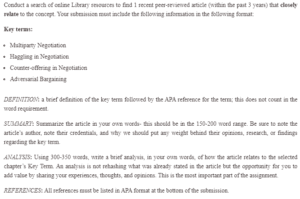Multiparty Negotiation
Definition
Multiparty negotiation involves two or more parties in a bargaining room to exchange ideas, views, or perspectives (Kern, 2020).
Summary
According to the document about Multiparty negotiation, the author explains its roles, principles, functions, and importance. The author states that part of Multiparty negotiation is to make exchanges with the individuals whereby behaviors can be outlined into the hindering or helping individuals’ productivity at their workplace. The author explains the principles under Multiparty negotiation: The first principle is Reciprocity, where there is a question about if an individual will want others to treat other people how they want to. The second principle is Publicity, whereby an individual should be aware if they can be comfortable when their actions are exposed. The third principle is that friends are trusted. Individuals should know whether they can be comfortable narrating to their children, friends, or spouse. The fourth principle is Universality, whereby an individual should see if they can advise on acting the way they did. The fifth principle is a legacy, whereby individuals should know whether their actions can reflect how they want to be known or remembered. The author also explains why Multiparty negotiation is necessary and states that its main importance is when negotiations are carried out and questions are asked. Later, solutions were made to a specific agreement. There are also rules given about Multiparty negotiation that helps govern it (Kern, 2020).
Analysis
The articles relate significantly to Multiparty negotiation because the author explains every process, method, and step taken to meet. Multiparty negotiation can be practiced in the organization to resolve things or issues. For instance, if individuals want some parts to be achieved in an organization while others are not ready for the action, they will need to make or go through legitimatization to settle down on a specific or significant decision. Hence Multiparty negotiation can help different group members have the ability to settle or get into one of the agreements. Although the agreement they will finally make is not what they would have wholly wanted, it will be halfway whereby both parties can benefit from the decisions. Multiparty negotiation is beneficial in organizations in a lot of ways. This is with the reason that it always leads to settling peace. When Multiparty negotiation is usually made, both parties will have no feelings of hating others for what decisions have been put in place and resolving disputes. In my opinion, it is essential to have Multiparty negotiations in places where there are different parties in the area since it will positively be beneficial in helping the individuals to be able to know what steps that can be made or taken in the organization so that they can reach or meet their agreement. According to the article, I learned that some things that should not be done in the Multiparty negotiation process are that no one should trust anyone else but themselves and the ideas they have in place. When this happens, they will put everyone’s ideas and discuss them, then the one that will be suitable will be considered and put in place after an agreement (Kern, 2020).
Reference
Kern, M. C., Brett, J. M., Weingart, L. R., & Eck, C. S. (2020). The “fixed” pie perception and strategy in dyadic versus multiparty negotiations. Organizational Behavior and Human Decision Processes, 157, 143-158.
ORDER A PLAGIARISM-FREE PAPER HERE
We’ll write everything from scratch
Question
Conduct a search of online Library resources to find 1 recent peer-reviewed article (within the past 3 years) that closely relate to the concept. Your submission must include the following information in the following format:

Multiparty Negotiation
Key terms:
- Multiparty Negotiation
- Haggling in Negotiation
- Counter-offering in Negotiation
- Adversarial Bargaining
DEFINITION: a brief definition of the key term followed by the APA reference for the term; this does not count in the word requirement.
SUMMARY: Summarize the article in your own words- this should be in the 150-200 word range. Be sure to note the article’s author, note their credentials, and why we should put any weight behind their opinions, research, or findings regarding the key term.
ANALYSIS: Using 300-350 words, write a brief analysis, in your own words, of how the article relates to the selected chapter’s Key Term. An analysis is not rehashing what was already stated in the article but the opportunity for you to add value by sharing your experiences, thoughts, and opinions. This is the most important part of the assignment.
REFERENCES: All references must be listed in APA format at the bottom of the submission.
(continued) Be sure to use the headers in your submission to ensure that all assignment aspects are completed as required.
Any plagiarism, including cutting and pasting, will result in zero points for the entire assignment.

